2016 Hyundai Grand Santa Fe towing
[x] Cancel search: towingPage 15 of 717
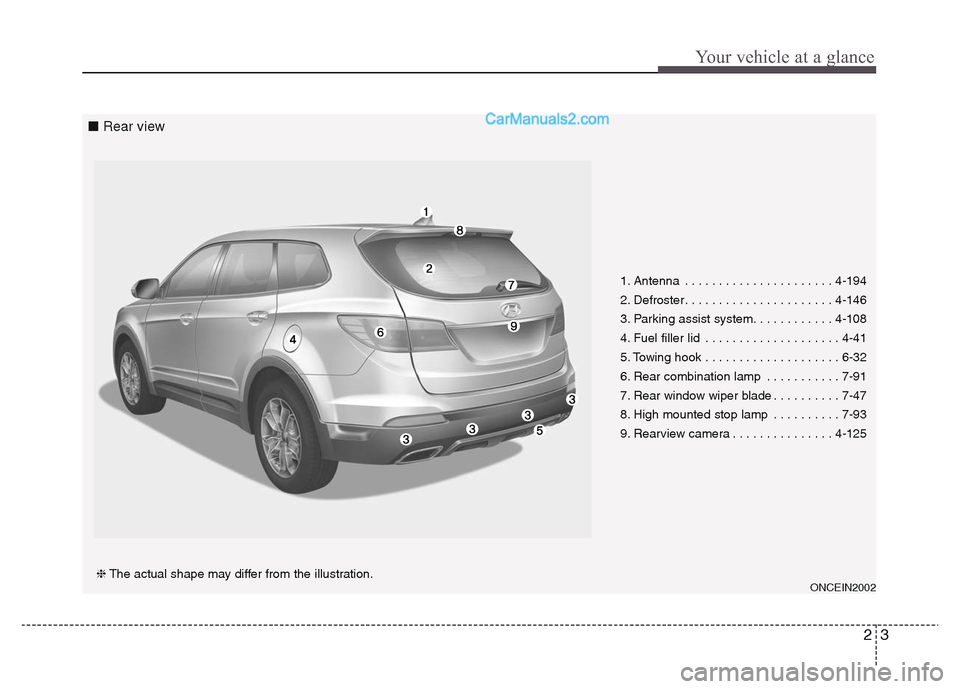
23
Your vehicle at a glance
1. Antenna . . . . . . . . . . . . . . . . . . . . . . 4-194
2. Defroster. . . . . . . . . . . . . . . . . . . . . . 4-146
3. Parking assist system. . . . . . . . . . . . 4-108
4. Fuel filler lid . . . . . . . . . . . . . . . . . . . . 4-41
5. Towing hook . . . . . . . . . . . . . . . . . . . . 6-32
6. Rear combination lamp . . . . . . . . . . . 7-91
7. Rear window wiper blade . . . . . . . . . . 7-47
8. High mounted stop lamp . . . . . . . . . . 7-93
9. Rearview camera . . . . . . . . . . . . . . . 4-125
ONCEIN2002❈The actual shape may differ from the illustration.
■ Rear view
Page 52 of 717
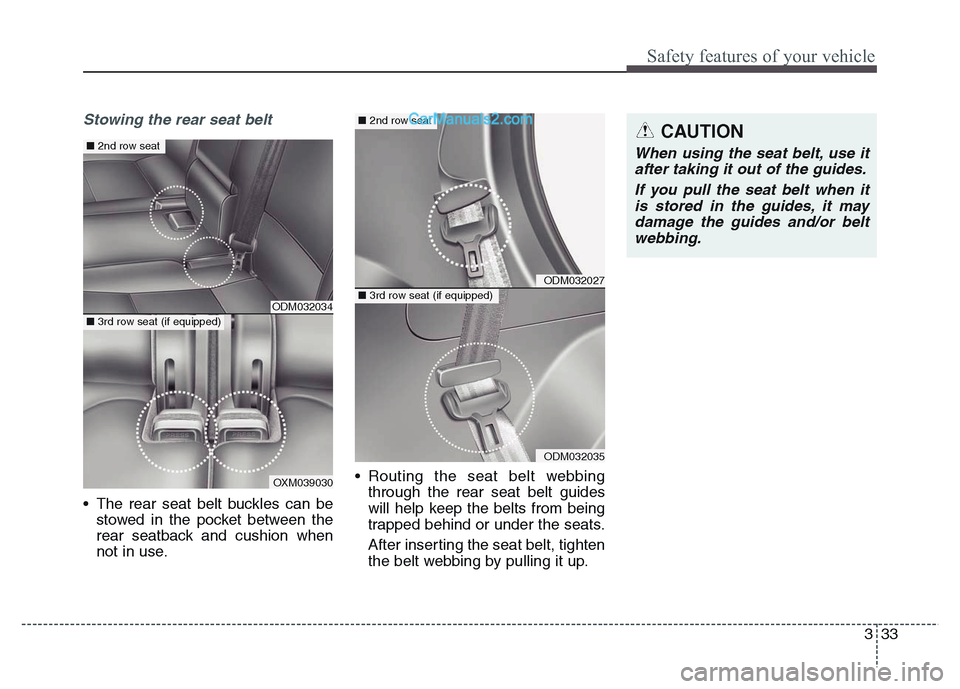
333
Safety features of your vehicle
Stowing the rear seat belt
• The rear seat belt buckles can be
stowed in the pocket between the
rear seatback and cushion when
not in use.• Routing the seat belt webbing
through the rear seat belt guides
will help keep the belts from being
trapped behind or under the seats.
After inserting the seat belt, tighten
the belt webbing by pulling it up.
ODM032034
OXM039030
■2nd row seat
■3rd row seat (if equipped)
ODM032027
ODM032035
■2nd row seat
■3rd row seat (if equipped)
CAUTION
When using the seat belt, use it
after taking it out of the guides.
If you pull the seat belt when it
is stored in the guides, it may
damage the guides and/or belt
webbing.
Page 202 of 717
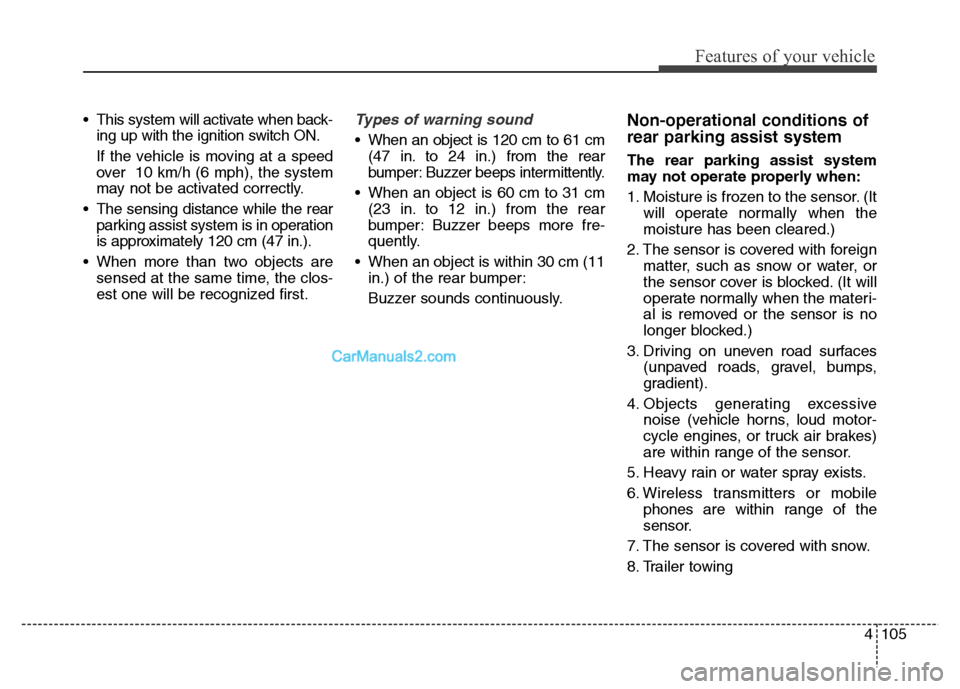
4105
Features of your vehicle
• This system will activate when back-
ing up with the ignition switch ON.
If the vehicle is moving at a speed
over 10 km/h (6 mph), the system
may not be activated correctly.
• The sensing distance while the rear
parking assist system is in operation
is approximately 120 cm (47 in.).
• When more than two objects are
sensed at the same time, the clos-
est one will be recognized first.Types of warning sound
• When an object is 120 cm to 61 cm
(47 in. to 24 in.) from the rear
bumper: Buzzer beeps intermittently.
• When an object is 60 cm to 31 cm
(23 in. to 12 in.) from the rear
bumper: Buzzer beeps more fre-
quently.
• When an object is within 30 cm (11
in.) of the rear bumper:
Buzzer sounds continuously.
Non-operational conditions of
rear parking assist system
The rear parking assist system
may not operate properly when:
1. Moisture is frozen to the sensor. (It
will operate normally when the
moisture has been cleared.)
2. The sensor is covered with foreign
matter, such as snow or water, or
the sensor cover is blocked. (It will
operate normally when the materi-
al is removed or the sensor is no
longer blocked.)
3. Driving on uneven road surfaces
(unpaved roads, gravel, bumps,
gradient).
4. Objects generating excessive
noise (vehicle horns, loud motor-
cycle engines, or truck air brakes)
are within range of the sensor.
5. Heavy rain or water spray exists.
6. Wireless transmitters or mobile
phones are within range of the
sensor.
7. The sensor is covered with snow.
8. Trailer towing
Page 451 of 717
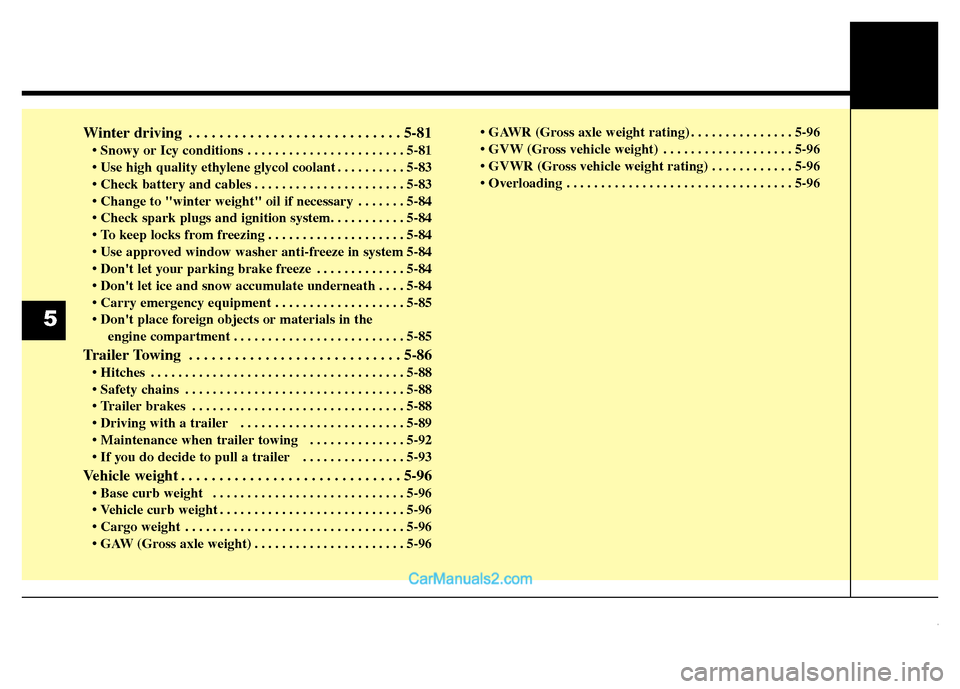
Winter driving . . . . . . . . . . . . . . . . . . . . . . . . . . . . 5-81
• Snowy or Icy conditions . . . . . . . . . . . . . . . . . . . . . . . 5-81
• Use high quality ethylene glycol coolant . . . . . . . . . . 5-83
• Check battery and cables . . . . . . . . . . . . . . . . . . . . . . 5-83
• Change to "winter weight" oil if necessary . . . . . . . 5-84
• Check spark plugs and ignition system. . . . . . . . . . . 5-84
• To keep locks from freezing . . . . . . . . . . . . . . . . . . . . 5-84
• Use approved window washer anti-freeze in system 5-84
• Don't let your parking brake freeze . . . . . . . . . . . . . 5-84
• Don't let ice and snow accumulate underneath . . . . 5-84
• Carry emergency equipment . . . . . . . . . . . . . . . . . . . 5-85
• Don't place foreign objects or materials in the
engine compartment . . . . . . . . . . . . . . . . . . . . . . . . . 5-85
Trailer Towing . . . . . . . . . . . . . . . . . . . . . . . . . . . . 5-86
• Hitches . . . . . . . . . . . . . . . . . . . . . . . . . . . . . . . . . . . . . 5-88
• Safety chains . . . . . . . . . . . . . . . . . . . . . . . . . . . . . . . . 5-88
• Trailer brakes . . . . . . . . . . . . . . . . . . . . . . . . . . . . . . . 5-88
• Driving with a trailer . . . . . . . . . . . . . . . . . . . . . . . . 5-89
• Maintenance when trailer towing . . . . . . . . . . . . . . 5-92
• If you do decide to pull a trailer . . . . . . . . . . . . . . . 5-93
Vehicle weight . . . . . . . . . . . . . . . . . . . . . . . . . . . . . 5-96
• Base curb weight . . . . . . . . . . . . . . . . . . . . . . . . . . . . 5-96
• Vehicle curb weight . . . . . . . . . . . . . . . . . . . . . . . . . . . 5-96
• Cargo weight . . . . . . . . . . . . . . . . . . . . . . . . . . . . . . . . 5-96
• GAW (Gross axle weight) . . . . . . . . . . . . . . . . . . . . . . 5-96• GAWR (Gross axle weight rating) . . . . . . . . . . . . . . . 5-96
• GVW (Gross vehicle weight) . . . . . . . . . . . . . . . . . . . 5-96
• GVWR (Gross vehicle weight rating) . . . . . . . . . . . . 5-96
• Overloading . . . . . . . . . . . . . . . . . . . . . . . . . . . . . . . . . 5-96
5
Page 535 of 717
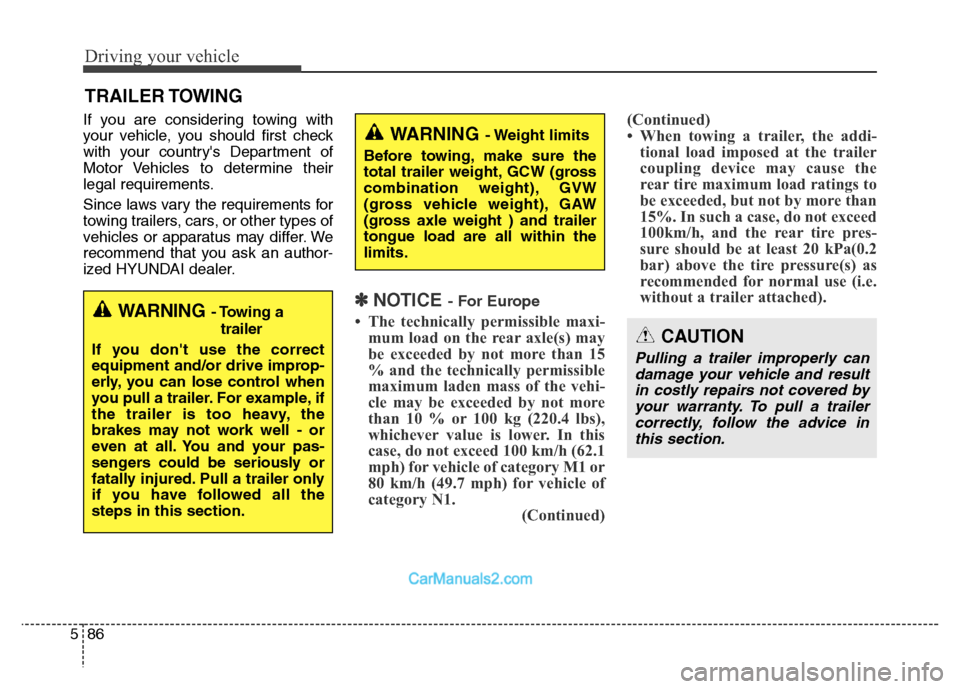
Driving your vehicle
86 5
If you are considering towing with
your vehicle, you should first check
with your country's Department of
Motor Vehicles to determine their
legal requirements.
Since laws vary the requirements for
towing trailers, cars, or other types of
vehicles or apparatus may differ. We
recommend that you ask an author-
ized HYUNDAI dealer.
✽NOTICE - For Europe
• The technically permissible maxi-
mum load on the rear axle(s) may
be exceeded by not more than 15
% and the technically permissible
maximum laden mass of the vehi-
cle may be exceeded by not more
than 10 % or 100 kg (220.4 lbs),
whichever value is lower. In this
case, do not exceed 100 km/h (62.1
mph) for vehicle of category M1 or
80 km/h (49.7 mph) for vehicle of
category N1.
(Continued)(Continued)
• When towing a trailer, the addi-
tional load imposed at the trailer
coupling device may cause the
rear tire maximum load ratings to
be exceeded, but not by more than
15%. In such a case, do not exceed
100km/h, and the rear tire pres-
sure should be at least 20 kPa(0.2
bar) above the tire pressure(s) as
recommended for normal use (i.e.
without a trailer attached).
TRAILER TOWING
CAUTION
Pulling a trailer improperly can
damage your vehicle and result
in costly repairs not covered by
your warranty. To pull a trailer
correctly, follow the advice in
this section.
WARNING- Towing a
trailer
If you don't use the correct
equipment and/or drive improp-
erly, you can lose control when
you pull a trailer. For example, if
the trailer is too heavy, the
brakes may not work well - or
even at all. You and your pas-
sengers could be seriously or
fatally injured. Pull a trailer only
if you have followed all the
steps in this section.
WARNING- Weight limits
Before towing, make sure the
total trailer weight, GCW (gross
combination weight), GVW
(gross vehicle weight), GAW
(gross axle weight ) and trailer
tongue load are all within the
limits.
Page 538 of 717
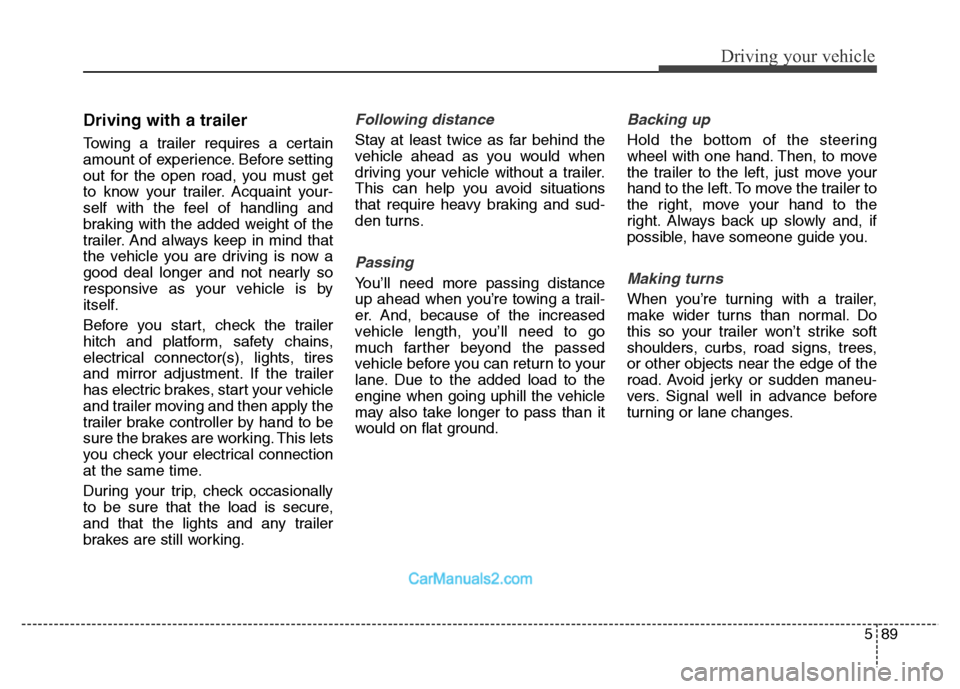
589
Driving your vehicle
Driving with a trailer
Towing a trailer requires a certain
amount of experience. Before setting
out for the open road, you must get
to know your trailer. Acquaint your-
self with the feel of handling and
braking with the added weight of the
trailer. And always keep in mind that
the vehicle you are driving is now a
good deal longer and not nearly so
responsive as your vehicle is by
itself.
Before you start, check the trailer
hitch and platform, safety chains,
electrical connector(s), lights, tires
and mirror adjustment. If the trailer
has electric brakes, start your vehicle
and trailer moving and then apply the
trailer brake controller by hand to be
sure the brakes are working. This lets
you check your electrical connection
at the same time.
During your trip, check occasionally
to be sure that the load is secure,
and that the lights and any trailer
brakes are still working.
Following distance
Stay at least twice as far behind the
vehicle ahead as you would when
driving your vehicle without a trailer.
This can help you avoid situations
that require heavy braking and sud-
den turns.
Passing
You’ll need more passing distance
up ahead when you’re towing a trail-
er. And, because of the increased
vehicle length, you’ll need to go
much farther beyond the passed
vehicle before you can return to your
lane. Due to the added load to the
engine when going uphill the vehicle
may also take longer to pass than it
would on flat ground.
Backing up
Hold the bottom of the steering
wheel with one hand. Then, to move
the trailer to the left, just move your
hand to the left. To move the trailer to
the right, move your hand to the
right. Always back up slowly and, if
possible, have someone guide you.
Making turns
When you’re turning with a trailer,
make wider turns than normal. Do
this so your trailer won’t strike soft
shoulders, curbs, road signs, trees,
or other objects near the edge of the
road. Avoid jerky or sudden maneu-
vers. Signal well in advance before
turning or lane changes.
Page 539 of 717
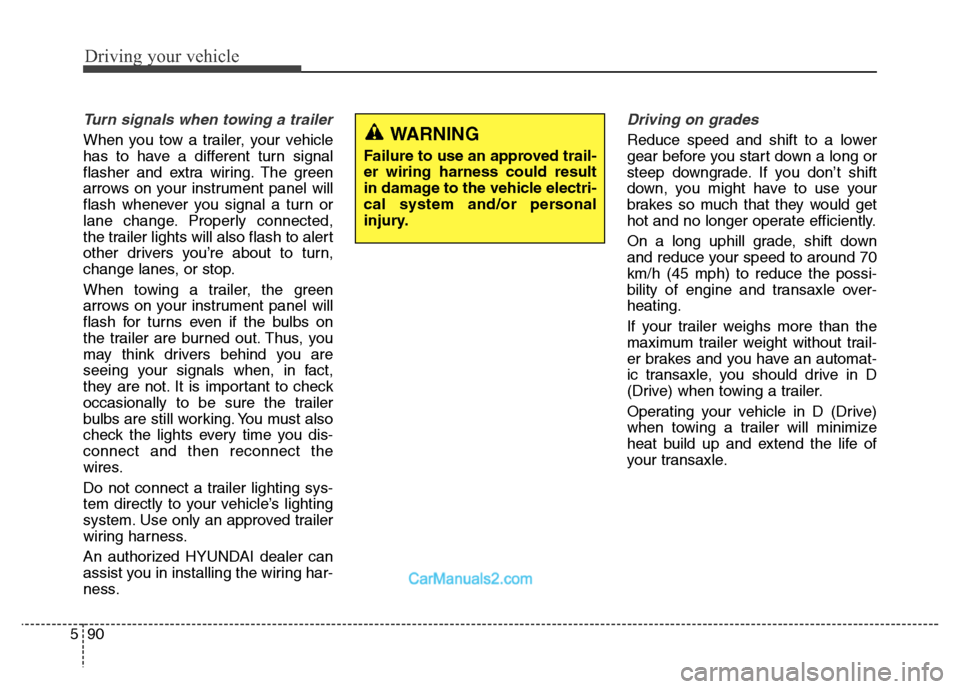
Driving your vehicle
90 5
Turn signals when towing a trailer
When you tow a trailer, your vehicle
has to have a different turn signal
flasher and extra wiring. The green
arrows on your instrument panel will
flash whenever you signal a turn or
lane change. Properly connected,
the trailer lights will also flash to alert
other drivers you’re about to turn,
change lanes, or stop.
When towing a trailer, the green
arrows on your instrument panel will
flash for turns even if the bulbs on
the trailer are burned out. Thus, you
may think drivers behind you are
seeing your signals when, in fact,
they are not. It is important to check
occasionally to be sure the trailer
bulbs are still working. You must also
check the lights every time you dis-
connect and then reconnect the
wires.
Do not connect a trailer lighting sys-
tem directly to your vehicle’s lighting
system. Use only an approved trailer
wiring harness.
An authorized HYUNDAI dealer can
assist you in installing the wiring har-
ness.
Driving on grades
Reduce speed and shift to a lower
gear before you start down a long or
steep downgrade. If you don’t shift
down, you might have to use your
brakes so much that they would get
hot and no longer operate efficiently.
On a long uphill grade, shift down
and reduce your speed to around 70
km/h (45 mph) to reduce the possi-
bility of engine and transaxle over-
heating.
If your trailer weighs more than the
maximum trailer weight without trail-
er brakes and you have an automat-
ic transaxle, you should drive in D
(Drive) when towing a trailer.
Operating your vehicle in D (Drive)
when towing a trailer will minimize
heat build up and extend the life of
your transaxle.WARNING
Failure to use an approved trail-
er wiring harness could result
in damage to the vehicle electri-
cal system and/or personal
injury.
Page 540 of 717
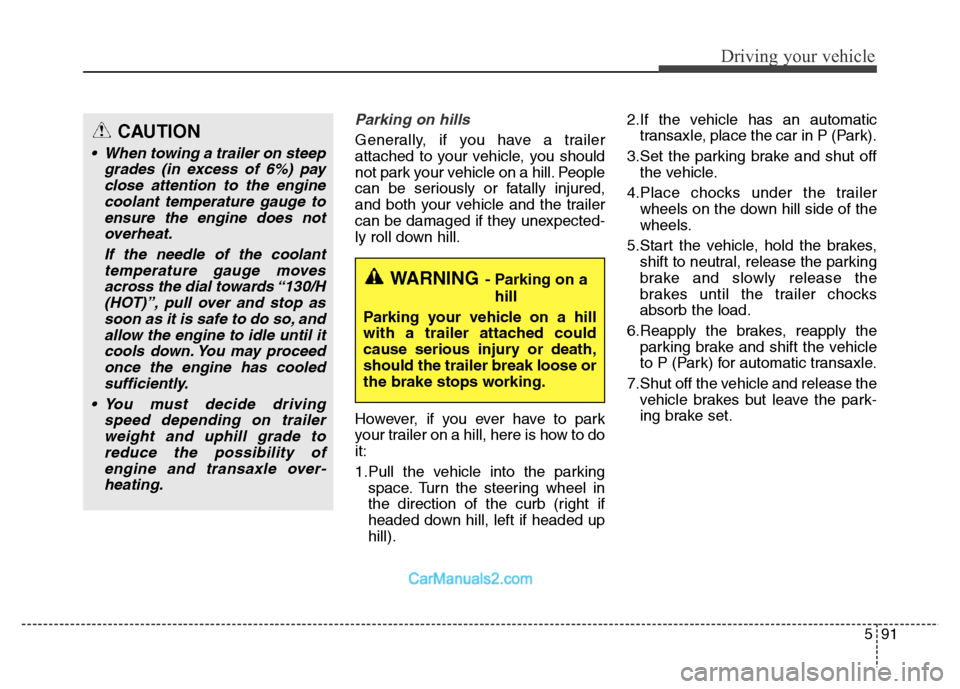
591
Driving your vehicle
Parking on hills
Generally, if you have a trailer
attached to your vehicle, you should
not park your vehicle on a hill. People
can be seriously or fatally injured,
and both your vehicle and the trailer
can be damaged if they unexpected-
ly roll down hill.
However, if you ever have to park
your trailer on a hill, here is how to do
it:
1.Pull the vehicle into the parking
space. Turn the steering wheel in
the direction of the curb (right if
headed down hill, left if headed up
hill).2.If the vehicle has an automatic
transaxle, place the car in P (Park).
3.Set the parking brake and shut off
the vehicle.
4.Place chocks under the trailer
wheels on the down hill side of the
wheels.
5.Start the vehicle, hold the brakes,
shift to neutral, release the parking
brake and slowly release the
brakes until the trailer chocks
absorb the load.
6.Reapply the brakes, reapply the
parking brake and shift the vehicle
to P (Park) for automatic transaxle.
7.Shut off the vehicle and release the
vehicle brakes but leave the park-
ing brake set.CAUTION
• When towing a trailer on steep
grades (in excess of 6%) pay
close attention to the engine
coolant temperature gauge to
ensure the engine does not
overheat.
If the needle of the coolant
temperature gauge moves
across the dial towards “130/H
(HOT)”, pull over and stop as
soon as it is safe to do so, and
allow the engine to idle until it
cools down. You may proceed
once the engine has cooled
sufficiently.
• You must decide driving
speed depending on trailer
weight and uphill grade to
reduce the possibility of
engine and transaxle over-
heating.
WARNING- Parking on a
hill
Parking your vehicle on a hill
with a trailer attached could
cause serious injury or death,
should the trailer break loose or
the brake stops working.